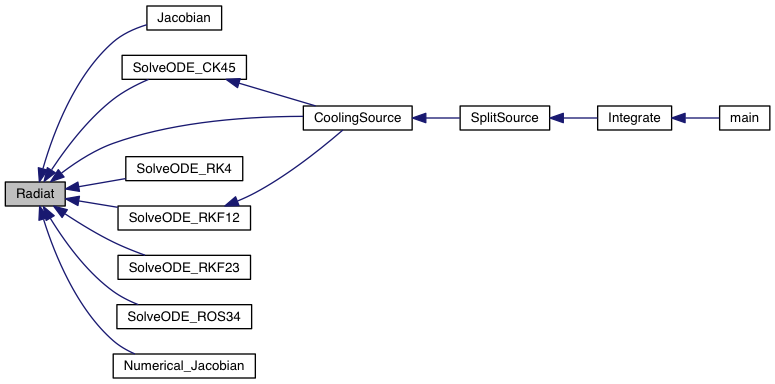|
PLUTO
|
|
PLUTO
|
Go to the source code of this file.
Macros | |
| #define | NIONS 3 |
| #define | X_HI (NFLX) |
| #define | X_H2 (NFLX + 1) |
| #define | X_HII (NFLX + 2) |
Functions | |
| void | CompEquil (double n, double T, double *v) |
| double | GetMaxRate (double *, double *, double) |
| void | Radiat (double *, double *) |
| void | NormalizeIons (double *) |
| void | H2RateTables (double, double *) |
| void CompEquil | ( | double | N, |
| double | T, | ||
| double * | v0 | ||
| ) |
| [in] | n | the particle number density (not needed, but kept for compatibility) |
| [in] | T | the temperature (in K) for which equilibrium must be found. |
| [in,out] | v | an array of primitive variables. On input, only density needs to be defined. On output, fractions will be updated to the equilibrium values. |
Compute the equilibrium ionization balance for (rho,T)
Definition at line 44 of file comp_equil.c.
| double GetMaxRate | ( | double * | v0, |
| double * | k1, | ||
| double | T0 | ||
| ) |
Return an estimate of the maximum rate (dimension 1/time) in the chemical network. This will serve as a "stiffness" detector in the main ode integrator.
For integration to be carried explicitly all the time, return a small value (1.e-12).
Definition at line 4 of file maxrate.c.

| void H2RateTables | ( | double | T, |
| double * | krvals | ||
| ) |
On first call, compute and store rate coefficient arrays needed for the H2_COOL module. On subsequent calls, use linear interpolation between adjacent tabulated values to obtain the coefficients at the desired temperature T.
Definition at line 7 of file radiat.c.


| void NormalizeIons | ( | double * | ) |

| void Radiat | ( | double * | v, |
| double * | rhs | ||
| ) |
Cooling for optically thin plasma up to about 200,000 K Plasma composition: H, HeI-II, CI-V, NI-V, OI-V, NeI-V, SI-V Assumed abundances in elem_ab Uses S : Array = Variables vector x line points rhs : output for the system of ODE ibeg, iend : begin and end points of the current line
Cooling for neutral or singly ionized gas: good up to about 35,000 K in equilibrium or shocks in neutral gas up to about 80 km/s. Assumed abundances in ab Uses t : Kelvin dene : electron density cm*-3 fneut : hydrogen neutral fraction (adimensionale) ci,cr : H ionization and recombination rate coefficients
em(1) = TOTAL EMISSIVITY : (ergs cm**3 s**-1) em(2) = Ly alpha + two photon continuum: Aggarwal MNRAS 202, 10**4.3 K em(3) = H alpha: Aggarwal, Case B em(4) = He I 584 + two photon + 623 (all n=2 excitations): Berrington &Kingston,JPB 20 em(5) = C I 9850 + 9823: Mendoza, IAU 103, 5000 K em(6) = C II, 156 micron: Mendoza, 10,000 K em(7) = C II] 2325 A: Mendoza, 15,000 K em(8) = N I 5200 A: Mendoza, 7500 K em(9) = N II 6584 + 6548 A: Mendoza em(10) = O I 63 micron: Mendoza,2500 K em(11) = O I 6300 A + 6363 A: Mendoza, 7500 K em(12) = O II 3727: Mendoza em(13) = Mg II 2800: Mendoza em(14) = Si II 35 micron: Dufton&Kingston, MNRAS 248 em(15) = S II 6717+6727: Mendoza em(16) = Fe II 25 micron: Nussbaumer&Storey em(17) = Fe II 1.6 micron em(18) = thermal energy lost by ionization em(19) = thermal energy lost by recombination (2/3 kT per recombination. The ionization energy lost is not included here.
Provide r.h.s. for tabulated cooling.
Definition at line 94 of file radiat.c.
